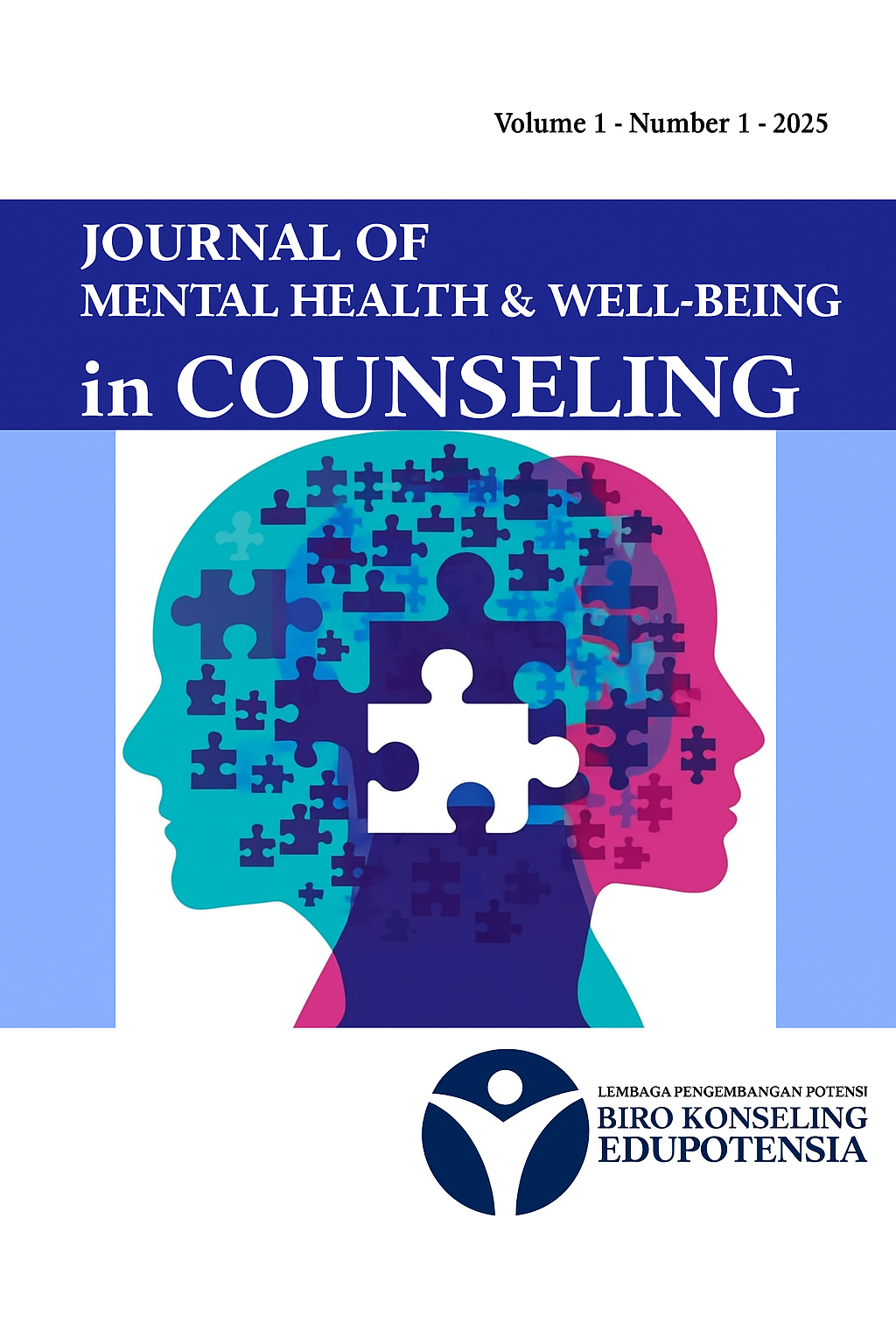Reality Counseling to Reduce Students' Cybersex Addiction Behavior: Protocol Guide
DOI:
https://doi.org/10.65067/5ypdth03Keywords:
Cybersex, Addiction, Reality Counseling, Protocol GuideAbstract
The turbulent sexual development of adolescents and their high curiosity about sexuality lead some teenagers to choose cybersex to satisfy their sexual desires. Cybersex is a behavior performed for sexual pleasure through media with internet connections stored in gadgets or computers, making it easier for some teenagers to access sexual content. Therefore, guidance and supervision from family, peer groups, schools, and school counselors are needed to provide information and help plan a better self-concept. Cybersex also has three categories: high addiction, moderate addiction, and low addiction. This behavior can result in emotional, social, and addiction-related disturbances that hinder development. Reality counseling is a service focused on current behavior. The WDEP method (Wants, Direction, Evaluation, Plan) helps students understand their behavior, control sexual impulses, and make healthier decisions by emphasizing individual responsibility and focusing on the present condition. It is expected that this service will improve students' self-control and reduce cybersex addiction.
Downloads
References
Arumsari, C., Sugara, G. S., & Yorgantara, G. A. (2022). Efektivitas Konseling Kognitif Perilaku Untuk Mereduksi Adiksi Cybersex. Journal of Innovative Counseling: Theory, Practice, and Research, 6(01).
Christiany, S. (2020). Psikologi Perkembangan Remaja. Jakarta: Prenada Media Group.
Cooper, A. R. (1999). Sexuality On The Internet: From Sexual Exploration To Pathological Expression. Professional Psychology: Research And Practice.
Cooper, A. (2002). Sex And The Internet: A Guidebook For Clinicians. London: : Brunner-Routledge.
Corey, G. (2005). Theory And Practice Of Counseling And Psychotherapy, 7th Edition. Belmont, California: Books/Cole, Thomson Learning.
Döring, N. M. (2009). The Internet’s Impact On Sexuality: A Critical Review Of 15 Years of Research. Computers In Human Behavior, 1089–1101.
Glasser, W. (2001). Counseling with Choice Theory: The New Realiy Therapy. New York: HarperCollins.
Glasser, W. (1965). Reality Therapy: A New Approach to Psychiatry. New York: Harper & Row.
Glasser, W., & Zunin, L. (1973). The Identity Society. New York: Harper & Row.
Glasser, W. (2003). Warning: Psychiatry Can Be Hazardous To Your Mental Health. New York: Harper Collins.
Griffiths, M. (2001). Sex on The Internet: Observations and Psychotherapy. Belmont, CA: Thomson Brooks/Cole.
Haryanti. (2001). Pengaruh Bimbingan Konseling Terhadap Perilaku Remaja. Jurnal Psikologi Indonesia Universitas Indonesia Press.
Harmini, L. (2018). Cybersex Dalam Perspektif Psikologi. Jakarta: Universitas Terbuka Press.
Jerome, L. e. (2000). Sex And The Internet: A Guidebook For Clinicians. New York: Brunner-Routledge.
Lazarus, A. A. (1991). The Practice Of Multimodal Therapy. New York: Guilford Press.
Maheu, M. (2011). Cybersex Addiction And Compulsive Behavior. Journal Of Marital And Family Therapy.
Mutaqin. (2009 ). Cybersex And Sexual Compulsivity: A Comprehensive Review. Sexual Addiction & Compulsivity. Routledge.
Mutaqin, A. (2009). Pengaruh Kecanduan Cybersex Pada Perilaku Remaja. Medikes.
Nurihsan, Y. &. (2008). Landasan Bimbingan Dan Konseling. Bandung: PT. Remaja Rosdakarya.
Palmer, S. (2011). Konseling dan Psikoterapi. Yogyakarta: Pustaka Pelajar.
Wardani, J. N. P., Sugara, G. S., & Rahimsyah, A. P. (2023). Analisis Kecenderungan Perilaku Bullying pada Remaja. Buletin Konseling Inovatif, 3(3), 226-236.
Schwartz, M. F. (2000). Compulsive Cybersex: The Newest Addiction. Sexual Addiction & Compulsivity, 7(1-2), 1-18.
Tifani. (2014). Peran Konseling Dalam Mencegah Perilaku Cybersex Pada Remaja. Jurnal Konseling Dan Psikologi, Universitas Negeri Malang.
Utami & Amila. (2014). Faktor Pemicu Cybersex Di Kalangan Remaja. Jurnal Ilmiah PsikologiDan Kesehatan Mental.
Wery, A. &. (2017). Problematic Cybersex: Conceptualization, Assessment, And Treatment. Addictive Behaviors, 64, 238-246.
Wubbolding, R. E. (1998). Reality Therapy for the 21st Century. Philadelphia: Brunner/Mazel.
Ybarra, M. L. (2005). Exposure To Internet Pornography Among Children And Adolescents: A National Survey. Pediatrics, 116, E116-E121. DOI : 10.1542/Peds.2004-1103
Young, K. S. (1998). Internet Addiction: The Emergence Of A New Clinical Disorder. Cyberpsychology & Behavior, 1(3), 237-244.
Downloads
Published
Issue
Section
License
Copyright (c) 2025 Eva Nurul Fajriyah, Aam Imaddudin, Anandha Putri Rahimsyah (Author)

This work is licensed under a Creative Commons Attribution-ShareAlike 4.0 International License.













